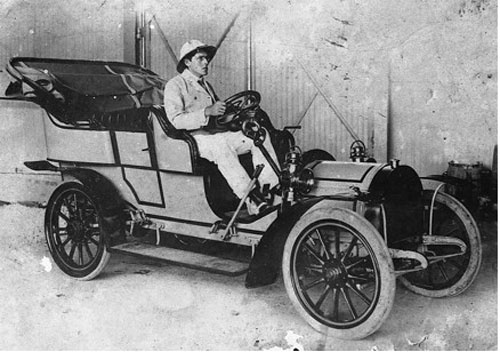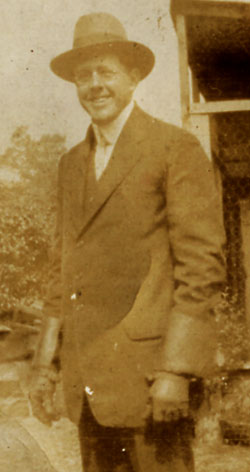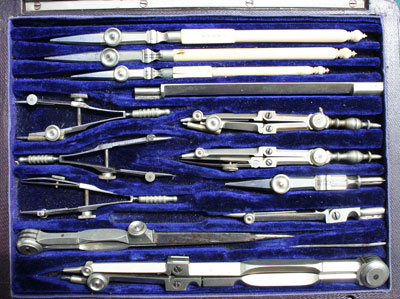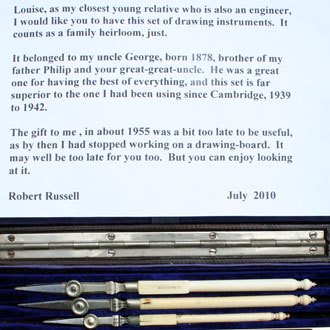
For the descendents of Richard Dearie and his son John Russell
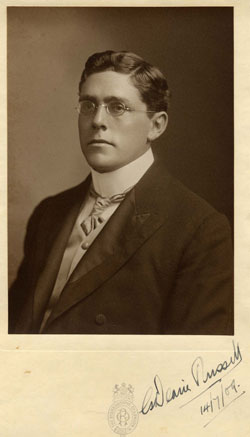
George Dearie Russell
Born 23 November 1879
Died 6 March 1947
Engineer
Written by Georgina Craufurd with additional notes by Claire Grey
George was born on 23 November 1879, the eldest son of John Russell and Francis Sophia Webster at 64 Waterloo Road. According to Charles Booth’s poverty map of London dated 1889, the streets on either side of the road were lived in by the “ middle class well to do”
The following is from a notebook in his handwriting dated 29 Novem 1896:
"Born 23 November 1879 in London. Removed to New Malden Surrey 1881 Started at Malden College in 1888 left .. in 1889.
Sailed for S’pore Feb. 1890. Arrived in S’pore Mar: 1890. Went to Raffles School 1892. Mother died 16 Jan 1893. Left Raffles in June 1894. Went to Victoria Institution Aug 94. Left Novem 94."
After the death of his mother in January 1893 his four brothers were sent to live with their Aunt and Uncle in London at 135 Chadwick Road, Peckham. George now aged 13 stayed at school in Singapore. He did not see his father again for a year from June 1893 to June 1894. He appears to be working hard at school but sad in the letters sent to his brother Archie in London.
His letters to Archie are from St Andrews House, Armenia Street, Singapore, Straits Settlements. On the 12/10/93 he writes that he has been given a banjo and is learning how to play, and that he is also principal actor in play. On his 14th birthday he tells Arch that he has not had a cake this birthday. On March 3 1894 he tells him that he is learning Algebra, Latin, Euclid, drawing and many other difficult subjects. He has won first prize in his class. He comments sadly that at the Easter holidays he supposes he will not get any Easter Eggs and that he wishes he could come to England to speak to him.
He returned on board the Sappho on 30 June to live with his father in KL in 1894 and attended the Victoria Institution from August to November of that year.
George's note book continues: "Started apprenticeship at Riley Hargreaves and Co. Engineers 2nd December 1894. Worked in shop till 4th May 1896 when joined the drawing office. Left drawing office about March 98. Went to KL acted foreman 3 and half mns (?) Went to shop 8/6/98 Entered drawing office again 11/7/98. Left drawing office 1/10/98 Started in shop at lathe 3/10/98. Left lathe went ()? To fitting shop 12-1-99."
He then lists his pay. “Drew from RH & Co. - July 4. 98 drew $30 20-7-98 $20 6-8-98 $20 24-8-98 $20 12-9-98 $25 15-10-98 $20 18-11-98 $25 1-12-89 $40 6-1-99 $40 8-2-99 $40 6-3-99 $40 3-4-99 $40”
The entries end here.
His father's letters give more news of him:
5 Nov 1895 George is returning from Australia much improved in health.
5 May 1896 George greets his father on his visit to Singapore they haven’t met for 18 months. His father tells Archie in his letters “ He (George) was very thin and tall and wears glasses, and takes the greatest interest in his work. He was in the shops for some time, and has done a good bit of work on steam launches, but just now he has gone into the drawing office, where I expect he will stay for a year or more. The principals of his firm speak highly of him and I think he will do well. I saw some of the model ships he has been making and he seems to be very clever. He is now ”building” a ship, quite an undertaking. He still attends night class for mathematics and in fact seems to have his time fully occupied.”
Jack’s letter goes on to tell Archie how he and George went to a concert and on Saturday they both visited the cemetery where George had been taking care of his mother’s grave.
In 1899 Jack returns to UK and returns to KL with George’s brothers.
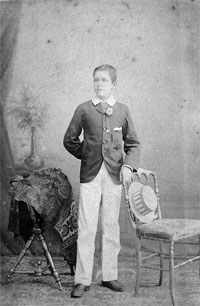
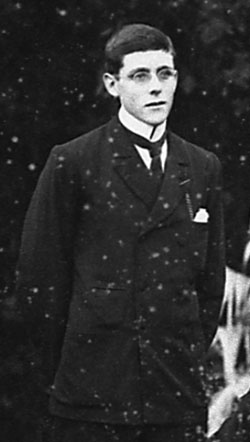
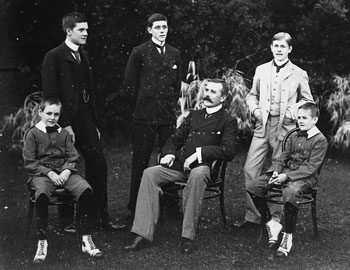
Extracts from Archie's diaries:
” 1899 George started on 2nd May as fourth engineer SS Clitus Sal £8 per mensum. “1900 George arrives by the SS Malacca from Singapore. Some time previous father has heard that Mr. Robertson the manager of the Federated Engineering Company wanted an assistant and one day while talking to Mr R. Mr. R. said that he had offered the job to Mr. Wilson (foreman of the SGR works with a salary of $250 per mensem) and $20 house allowance. He believed however that Mr. W. would refuse it in which case he could wish for no better assistant than George. Shortly afterwards father received a letter from Mr. C.E.F. Sanderson telling him of the vacancy and advising him to get George in.
Father had hitherto not thought much of the place but he then wrote to George telling him all the circumstances and saying he would write again if Mr. W. refused. On George receiving the letter at Calcutta he wired to know whether he should come. Father showed the letter to Mr. R. who said that Mr. W. had refused but that he did not want George to come until Mr. Mc Bean a director of the company who was in S’pore had gone home as Mr. McB. wanted to get a man from Howarth Erskins in whom Mr. R. did not want. Father wrote explaining to George but before George received it he again wired to father and said if he did not get the place he could get work at Riley Hargreaves in S’pore (he being sick of the sea)
Father then wired “come” and George left the SS Clitus at Calcutta and went on board the SS Darius where he worked his way from Calcutta to Singapore. June 18th Monday George started as assistant manager at the Federated Engineering Cy Ltd, on a salary of $170 per mensem and an old pneumatic bicycle for riding to office and back. Mr Robertson having decided to take George on whether Mr. Mc Bean had gone or not.
1900 October 4th George goes to Pahang to take the traction engine to Raub and back and to prove there is nothing wrong. Oct. 7 George returns from Pahang being unable to move the traction engine and Mr. Robertson goes up who moves it and sends it on to Raub in company with the Malay driver.
Oct. 31 George has violent pains in the stomach and goes to bed. Dr. Williams says it is inflammation of the bowels. He takes hot fermentations for the pain.
Nov. 5 Mon. Still increases so Dr. Lucy is called who says it is a very serious matter and he must be operated on at once. Father then calls Dr. Braddon who advises Dr. Lucy to wait 24 hours before operating and Miss Jessop is called in to act as nurse and after passing a bad night George begins to mend (?) so there is no operation.
Nov. 12 Miss Jessop leaves, as George is well enough to look after himself.
Nov. 15 George having recovered goes to Singapore for a change.
Nov. 28 George returns from Singapore where he stayed with the Darkes. During the time he was there he passed his 21st birthday and father made him a present of a gold Albert ($100)”
End of entries in Archie’s diary.
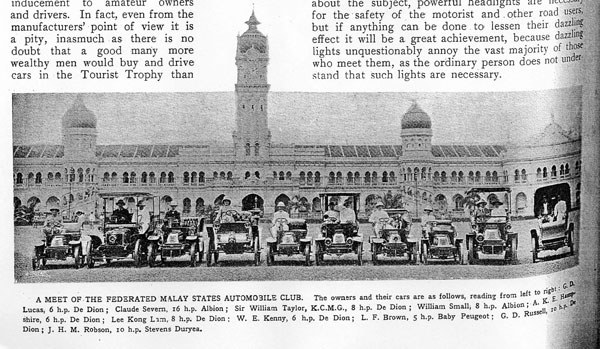
Left:
Allun Lupton provided this image from Autocar magazine dated October 21 1905.
It shows George in his 10 horse power De Dion second from the right with a woman in the passenger seat.
The picture is of a meeting of the Federated Malay States Automobile Club.
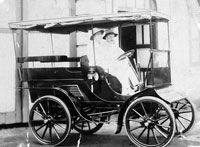

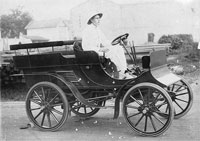
The Federated Engineering Company won the contract to build the first road bridge across the river Klang, (see right) which was completed in 1908. George with James Craig was in charge of the construction. It had four spans with a total length of 560 feet and cost $143.633 when it was completed in September. "The spot where the opening ceremony was to take place was also lavishly decorated and surmounted by a red awning and the bright garments of the native spectators added to the picturesqueness of the scene. His Excellency the High Commissioner and party, which included Mr. Claud Severn, Private Secretary, Capt. Gay, A.D.C., Col. Nelson, Commanding R.G.A. Major Ford, Army Service Corps and Mr. T.H. Reid of the Straits Times, travelled up by the Seamew. They were met at Port Swettenham by the Resident-General, Sir William Taylor, K.C.M.G., Mr. H.C. Belfield, British Resident, Selangor, Mr. C.E. Spooner, C.M.G., and Mrs. Spooner, who had arrived there by special train. His Excellency was met at Klang station by Mr. J. Scott Mason, D.O., Klang, and Mr. G.D. Russell, and the party proceeded by motor to the bridge. Here a guard of Honour of 50 police was stationed under Mr. W.W. Douglas and a large crowd had assembled, including a detachment of 200 Klang schoolboys. A feature was the large number of Malay ladies present decked out in brilliant attire. His Excellency was met at the bridge by His Highness the Sultan of Selangor, C.M.G. who had previously arrived by motor, and others present were Mr. M.S.H. McArthur, Acting Federal Secretary, Mr. J. Trump, Director of Public Works, F.M.S., Mr. E.R. Stokoe, State Engineer, Selangor, Mr. and Mrs. J. S. Mason, Mr. R.W. Harrison, Mr. H.M. Darby, Dr and Mrs. Gerrard, Mr. and Mrs. L.U. Stafford, Mr. and Mrs. W. Towgood, Mr. J. Gibson, Mr. A. Irving, Mr. E.F. Townley, Mr. C.T. Hamerton and Miss Hamerton, Mr. W.R.G. Hickey, Mr. F.O. Sander, Mr. Sydney Smith, Capt. Douglas of the Waterwitch and many others". The bridge was probably demolished during the war by the retreating British.For more on the bridge click here.
George was responsible for the design and construction of many bridges, roads and other works. He also designed the first rubber machinery.
Above: These car images with George at the wheel, appear to have been taken partly for advertising purposes, because they show the same model with the roof on and off. They have been produced by a professional photographer whose studio door can be seen in the background of the right hand picture in the bottom row. Jack and Archie can be seen with George in bottom row image on the left.
In 2005 Allun Lupton of the Veteran Car Club of Great Britain identified the top two models as a 1902 8 h.p. Albion, and the bottom two as a 10 h.p. de Dion from about 1903.
He thinks the model on the right may be a Vulcan from 1909.
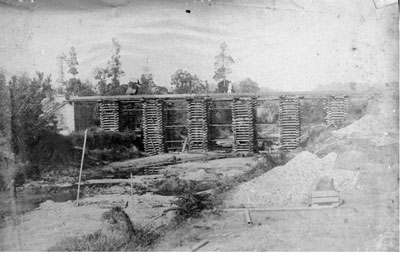
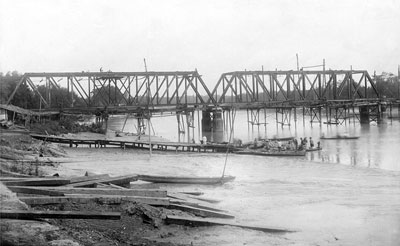

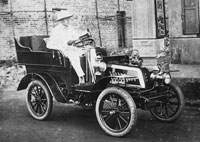
My grandfather George Dearie Russell died a month before I was born, so I never knew him. My mother remembers him with affection: but I don’t think ever knew him well because of the short time between her marriage to my father on 1 June 1946 and his death 6 months later.
Georgina Craufurd.
George became an engineer and in 1904 was made managing director of the Federated Engineering Co. at the age of 25.
The firm prospered and was the first in the country to import motorcars. One of the first cars introduced into F.M.S. was an American model called the Wyllis Knight.(1)
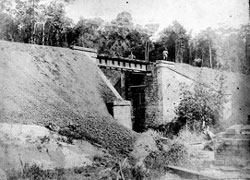
Membership of clubs and associations and willingness to put in time on their activities was the road to social acceptance. George was a Polo player and won trophies.
When George married, the Polo Club gave him their congratulations. His brother Bob was also a member.
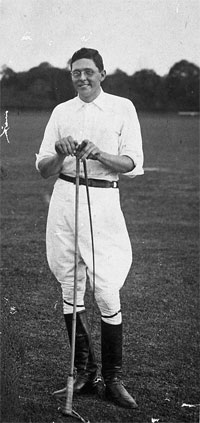
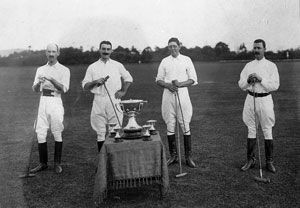
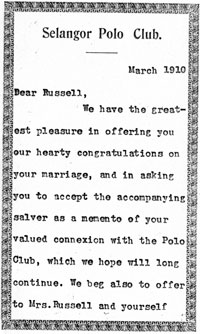
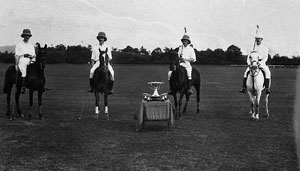
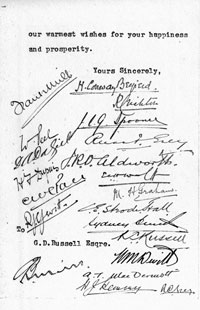
Before his marriage in 1909 George had a relationship with Meh Hiok which resulted in the birth of two, or possibly three, children. The oldest was Victor Edward Russell born on the 6 June 1907. His brother Gerard Lim was born about 1908. George kept this relationship and his children secret and Edward was asked to change his surname to Davidson when he was 14. Ted only revealed the truth about his ancestry in 2004 after keeping it a secret for more than 90 years.
On 11 September 1909 in England George married Madeleine Mossop. Madeleine's mother May wrote to George on 6 May 1909.
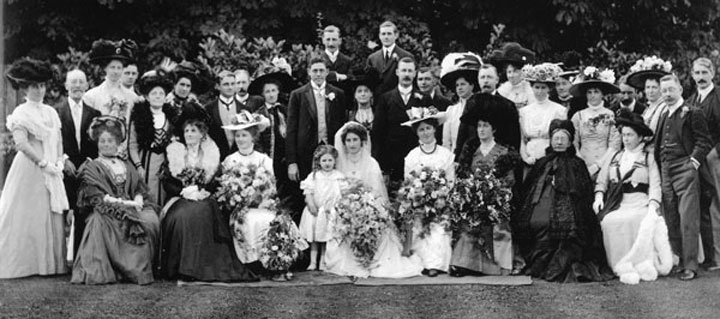
George's father Jack refused to come to the wedding because Emilie and Archie Rough had not been invited, although eventually Archie Rough attended with Don.
From the Golden Cross Hotel Charing Cross in London George wrote Emilie Rough a letter dated 30/8/09:: “ My dear Emilie, Many thanks indeed for your very kind present, which will be more appreciated than most in that I shall always carry it and that constantly using it will remind me of one who has been so kind to all the Russell tribe. I am sure that no one regrets more than I do the contretemps (good word but I am only safe at writing it) re the invitations; I am afraid I am almost as sick with my dear old father as I am with the other parties for having been greatly the cause of the whole affair- as you will no doubt appreciate, the bridge groom in these matters as in all others on the wedding day is little more than a cipher altho’ I have done my best and the others know my opinion quite well. Again many thanks dear Emilie and kind regards from George."
George was eight and half years older than his wife Madeleine Dearie Mossop, daughter of Henry Mossop and Mary Madeleine Mossop. She was born on 6th June 1888.
They were cousins, George's father Jack was half brother, to Annie Fox, Madeleine's grandmother. Both had the second name Dearie.
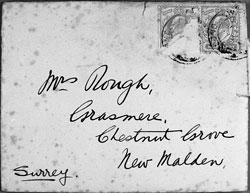
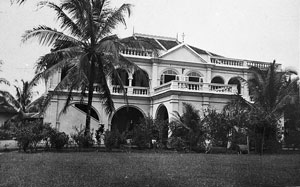
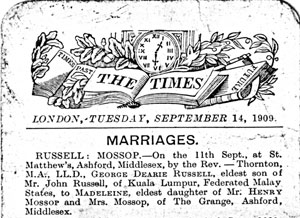
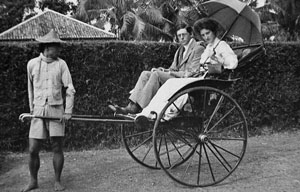
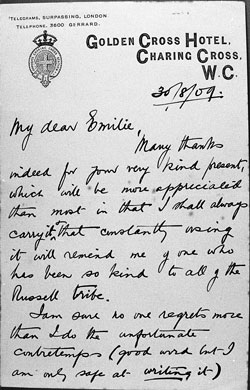
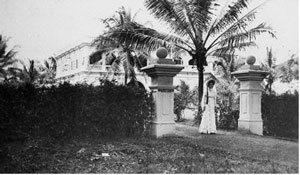
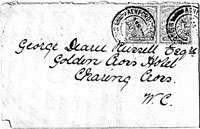
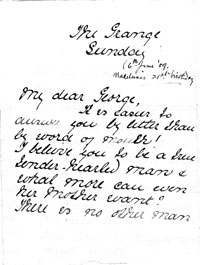
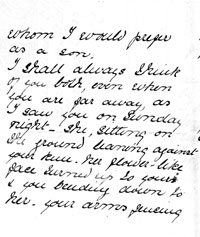
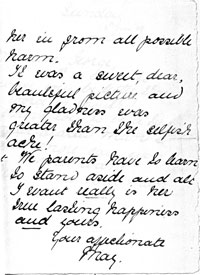
"My dear George, It is easier to answer your letter than by word of mouth! I believe you to be a true open hearted man and what more can even her mother want? There is no other man who I would prefer as a son. I shall always think of you both, even when you are far away, as I saw you on Sunday night- she sitting on the ground leaning against your knee. her flower like face turned up to yours & you bending down to her, your arms fencing her in from all possible harm. It was a sweet dear beautiful picture and my gladness was greater than the selfish ache! We parents have to learn to stand aside and all I want really is her true and lasting happiness and yours.
Your affectionate May."
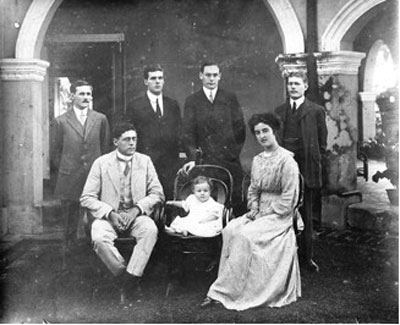
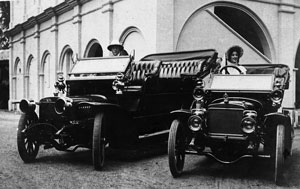
Kuala Lumpur 1909-1911
After the wedding George returned with Madeleine to KL. George's house was called Burford, a substantial building made of stone. They appear to have lived comfortably. Madeleine was reputed by her son to be the first woman to drive a car in the Malay States. Their only child John Dennis Russell, was born on 14th March 1911 in Kuala Lumpur. George wrote to May the following day.
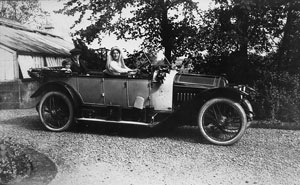
Scotland
They lived first at Bearsden on the Clyde, a suburb of Glasgow, where George co-founded the engineering firm Mitchell Russell.(2) George was chairman of Mitchell Russell and Co. up to the time of his death. Their London Showrooms were at 28 Berners Street, W1.
Addresses for the family in Archie's old address book include: Halley's Industrial Motors Ltd. Yoken, Glasgow or Aberdeen House, Benisden, Dumbartonshire.
During the First World War the firm manufactured ships.
George took advantage of the Clyde for sailing and a owned a small motor cruiser called "Golden Orfe" which had a clinker built double ended dinghy, (pointed at both ends), which is now in the national maritime Museum of Irvine, Scotland.
The firm was later taken over by Smith and Welstood.
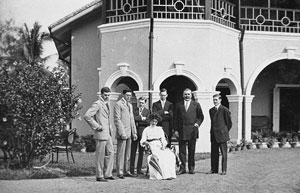
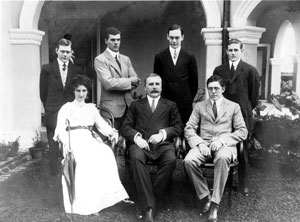
Letter to May on John's birth
“Kuala Lumpur Federated Malay States 15/3/11
My dear May,
I yesterday morning wired you the good news of the safe arrival of a beautiful boy; he arrived at 5.10 am and immediately notified his presence by a lusty yell, both his dear mother & himself are doing magnificently. M first felt the pains at about three in the morning of Monday & these steadily increased all day Monday until on Monday evening we sent to advise both Doctor & nurse that they might expect a call at any moment. Both came round to see her & arranged that the Doctor would come at 10pm that evening, (Monday) & if necessary order the nurse to come. Madeleine found the pains getting worse & finally when the Doctor came at 10pm I went for the nurse, poor M. was in great pain for a minute or so every five minutes, but kept on walking about, until about three in the morning when she became really bad & I went for the Doctor again, then after what appeared an awful time the baby was born at 5.10am. Although poor Madeleine had, as I suppose most people, a bad time, yet she was remarkably plucky & was talking away with the Doctor & myself at six ‘o’clock & she has since been remarkably well & bright. The Doctor say she has been the most normal case he has known for years- The boy, John Dennis Russell, is a splendid specimen, - seven pounds, dark blue eyes, fair complexion & really a fine little fellow. He has I fear, his father’s hands and feet but they will be better to work with. (mine have done very well for me). Madeleine was awake nearly all day yesterday, had a “ wash and brush up” at 9 o’clock last night & had a very good night (only waking twice), I saw her this morning at seven.”
Rest of letter missing.
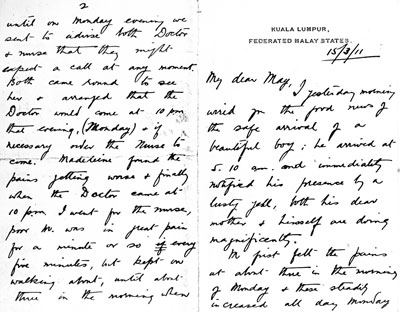
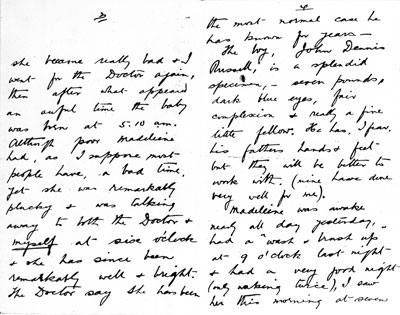
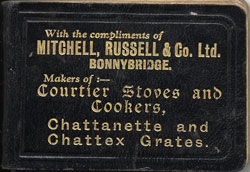
After the war in the mid twenties, George and Madeleine moved south, first to Esher, where they lived at “Esgair”, Portsmouth Road, Esher, Surrey then to Guildford, where their address was “Upmeads” London Road, Guildford, Surrey.
But they wanted to live near the coast. Georgina thinks that her grandfather choose Lymington because it was the only place on the South Coast which had both a good yachting harbour and a good rail connection to London. However, in a book about the Fawley branch of the Waterloo to Bournemouth line, the author mentions that three stations on the branch line were heated by Sentry boilers - invented by George. He may well have either come down to make sure that the specifications were right, or alternatively perhaps for the grand opening of the line in 1925. This may have contributed to his coming to the New Forest to live.
One of their first addresses there was "The Shipyard", c/o the Angel Hotel, Lymington Hants. George was a member of the Royal Lymington Yacht Club. He and Madeleine first became associated with Lymington in 1925.
George acquired a first world war HDML (Harbour Defence Motor Launch) that he converted into a motor yacht, called "Joyce", which they lived in on a mooring halfway down the Lymington River while they waited for the right house to come on the market. They lived on Joyce from 1930 at least, even though they did not move to East Grove until 1935.
They were already there in the summer of 1929 when their son John spent a ‘gap’ term before Oxford living on board, going to navigation school in Southampton and learning to paint watercolours.
There were also summer cruises to the West Country and over to France, to Cherbourg and Trouville. (The disadvantage was being incommunicado in winter; when John developed appendicitis at Oxford, the master of the college had to give permission for the operation, in loco parentis.)
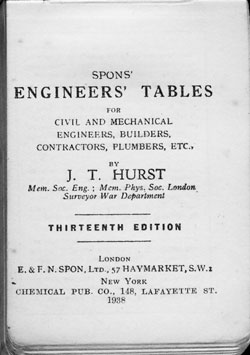
Entry in the London Gazette of 5 February 1926
"The partnership between Percy Neville Wood, George Dearie Russell and Frank Cornelius- Wheeler carrying on business as Engineers and Boiler makers at Central House, 34 and 36 Oxford street London W1 under the style or firm Wood, Russell and Co has been dissolved by mutual consent as from the 31 day of September 1925, so far as concerns Frank Cornelius- Wheeler who retires from the firm. All debts due to and owing by the said firm will be received and paid by the said Percy Neville Wood and George Dearie Russell who will continue the said business under the same style or firm of Wood, Russell and co.-
Dated this second day of February 1926 P. NEVILLE WOOD, G. DEARIE RUSSELL, F. CORNELIUS-WHEELER
1917 His father Jack perhaps aware of the danger of George's job sent him this letter for his 38th birthday. Thursday 22/11/1917. My dear Georgie Porgie, This, which I hope will reach you tomorrow morning, carries, with my love, my best wishes for your birthday & the hope that you will enjoy many, many more, each succeeding one happier than the last, so that in the fullness of time you will indeed be blest. My thoughts go back over the past years & I think of the many times you have given me reason to be proud of you and of no occasion on which you have caused me trouble. God bless you my dear boy, Love to you and yours, from Father. On the back is written:My "birthday gift" is, as fitting to these Times of a ? "reaful" nature, but again owing to these Times is not yet ready: it will follow later. Pa.
WW1 In the first world war he served as inspector of munitions having been given the important appointment at Woolwich connected with ammunition filling inspection.
The OBE he was awarded was listed in the Supplement to the London Gazette 7 June 1918:"George Dearie Russell Esq. Inspector, Gun Ammunition, Filling Factories, Ministry of munitions."
This may have been when they lived in Blackheath at 46, Lee Road Blackheath SE .
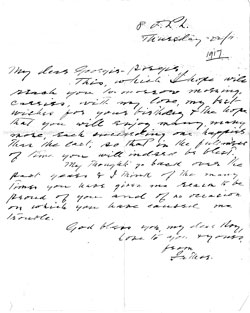
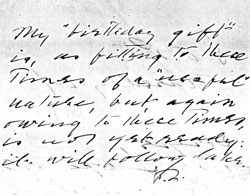
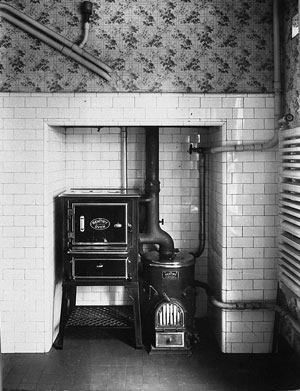
In 1935 they bought East Grove in Lymington.
The house was in a rather poor state when George bought it. Much practical modernisation was necessary: there was only been one bathroom (over the porch) and there was no central heating or electricity before he installed them.
He had the help of a young local architect Roger Pinkney RIBA (died c. 1980) who had been trained at the office of George Gilbert Scott the last of the Scott dynasty. He put in an up to date kitchen on the same level as the main front floor of the house, installed parquet flooring everywhere, added ornamental cornices and “panelling” ( there was no ornamental work in the house before.) He and George combed junk shops and Crowthers of Syon for Georgian mantelpieces to replace Victorian coloured marble ones put in in the 19th century and for ornamental iron gates for the garden.

Joyce the yacht was rather large for pottering in creeks, so just before the Second World War they sold her and commissioned Mr. May of the Berthon Boat Yard Co. in Lymington in 1937 to build them one of his “Gauntlet” canoe sterned boats to be called Lentune.
The yacht was laid up during the war, and George and Madeleine lived at East Grove with George’s younger brother Bob and his wife Lola, who had left Singapore at the outbreak of war.
In the WW2 George devoted much of his time and energy assisting his wife in the arrangements for the billeting of evacuees in the town (They also had a dog, a Jack Russell called Roddy, that their son John gave them. She (!) was named after his current ship HMS Rodney)
After the war John met his future wife Helen and George and Madeleine gave 'Lentune' to them as a wedding present in June 1946. Since Helen was a sailing novice, George went with them on their honeymoon sailing down to Cornwall. The wedding reception had been held in the garden of East Grove, as Helen's parents were moving house at the time.
The obituary in the Lymington Times reads:
"Notable Engineer. Death of Mr. G. Dearie Russell, OBE. His many friends learned with keen regret of the death of Mr. George Russell OBE, which occurred very suddenly at his home East Grove House on Thursday at the age of 67.
Mr. Russell who is survived by his wife and a married son went as a young man to the Malay States with his father, who was in the Civil Service. He became engineer and later managing director of Federated Engineering Co when still in his twenties. He was responsible for the design and construction of many bridges, roads and other works. Keen on invention Mr. Russell designed the first rubber machinery.
In the first world war (during which he was awarded the OBE) his qualifications led to his being given the an important appointment at Woolwich connected with ammunition filling inspection. Subsequently and up to the time of his death, Mr. Russell was chairman of Mitchell Russell and Co a foundry firm in Scotland.
His prowess as a polo player gained Mr. Russell several trophies. He was also an enthusiastic yachtsman, and was a member of the Royal Lymington Yacht Club. He and Mrs. Russell became associated with Lymington in 1925 and went to live at East Grove twelve years ago. In the late war Mr. Russell devoted much of his time and energy assisting his wife in the arrangements for the billeting of evacuees in the town.
The funeral at Bournemouth Crematorium on Monday was private."
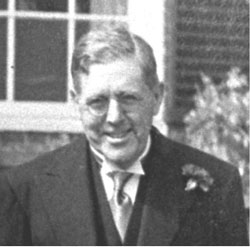
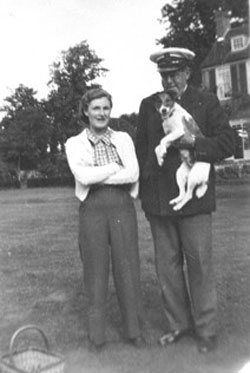
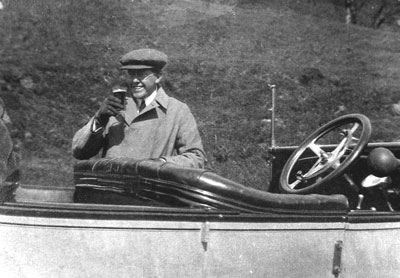

Not very long after on 6th March 1947 he died peacefully aged 67, of coronary thrombosis.
(He went upstairs to have a rest, half an hour later, he was gone) Madeleine survived him for over 20 years, dying in 1969.
Notes:
(1) David Russell recalled that the first car was an American Wyllis Knight. However it seems more likely that the first cars were Albions according to an article found by Allun Lipton of the veteran car Club of Great Britain. See below:
From " Autocar" 7 July 1906 "A Motor Car Race in Malaya". (A copy of an article from "The Times of Malaya") It comments on motor racing in Europe and and reports: "In Ipoh , where we have some of the most powerful and up to date cars in existence, such trials of speed and nerve have never yet been inaugurated. It has now been proposed to remedy this sad state of affairs, and in order to pave the way for further healthy competition, that a race shall be run between Albion cars... on a day to be fixed hereafter. To save accidents and petrol the course will be limited to 5 miles, and will extend from the junction of the Gopeng and Tambun Roads to the Tambun Mine." The "pet" names of the four cars and their owners and the rules are described. It concludes: "It may be interesting to add that the competing cars are 8h.p. Albion cars of the old horizontal engine type which the Albion Motor Car Co. sent out to our part of the world five years ago, which have been going steadily ever since, and are still reported to be doing good work.
"The following notes on the respective cars are supplied by Messrs. Riley, Hargeaves and Co. Ltd. Kinto Foundary, Gopeng Road, Ipoh, in a letter to Messrs Millar and Allan, Glasgow: 'Mis- fire'(age unknown) was the first car sent to the Malay States, and was for long a public service car. 'Wicket-Keep' was the first car sent to Osborne, the body being built in Singapore, sold afterwards to Wicket, then raffled and won by Corbett. 'Stormy-Petrol' was the second hand car you sent out per Lunnig to Tonoh Mines. 'The Parsons - Joy' is our big six seater car which was bought by Mr. Sanderson about four years ago. The Parson referred to is our shop foreman."
(2) FALKIRK Archives (Archon Code: GB558) Held by the Falkirk Commuinity Trust. Suite 1A, The Falkirk Stadium 4 Stadium Way Falkirk, FK2 9EE
"Records of Businesses: Iron foundries and Iron industries. Falkirk Archives holds a wide range of records of businesses. In this finding aid you will find a list of the records of companies relating to iron founding. The companies are listed in alphabetical order and the name of the company is printed in bold. A short history of the company is provided where possible.
Mitchell, Russell & Co Ltd Founded in 1886 at Bonnymuir Foundry, Bonnybridge, as George Mitchell & Son. Mitchell, Russell & Co took over Chattan Foundry in 1928 A908.004 1920s-1950s File of catalogues, price lists, correspondence and printed research papers relating to ironfounding and Chattan Foundry. Includes catalogue of Gillespies Ltd A908.002 Circa 1930s-1950s Catalogues and price lists A908.003 Circa 1930s-1950s Catalogues and price lists A897.002 Circa 1935 Catalogue, List No C.C.8 : The Chattanette patent combination grate A494.09 1939 List C.S. 41: Courtier stoves for comfort day and night A355.01 (1943) List No C.S.53: “For comfort install Courtier Stoves” A908.005 1950s Moulding Shop Reference Book A908.006 1960s Notebook - daily work record (?)
Some of the adverts for Mitchell and Russell can be seen here
